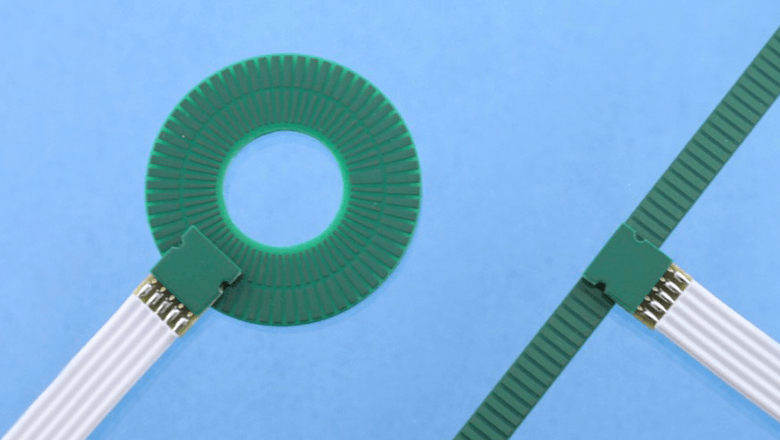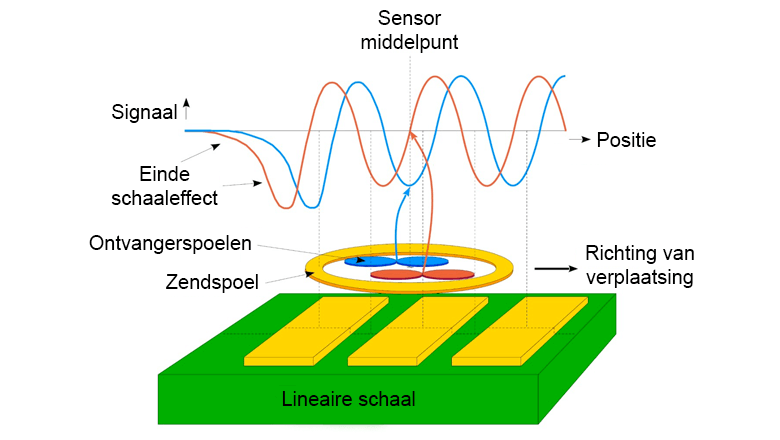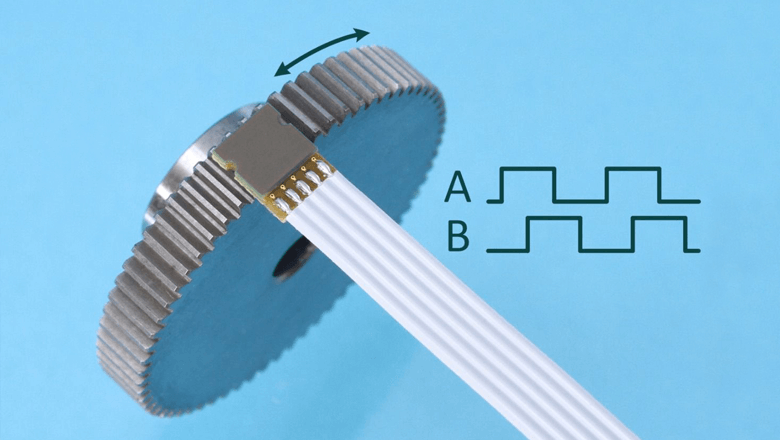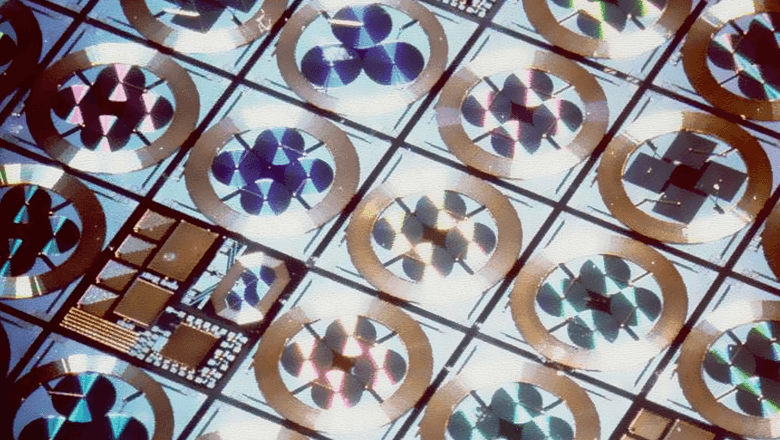Inductive encoder: accurately measure displacement in harsh conditions

An inductive encoder measures a displacement relative to a target. The displacement is translated into a movement. Such a linear encoder accurately detects a measurement between 5 and 15 µm (micrometer) contactlessly and is not sensitive to external (electro-) magnetic fields. In addition to inductive encoders, other technologies are also available. It can be quite challenging selecting the right technology. Which encoder is best suited for your application and environment?
The inductive encoder is still not yet well known by R&D engineers. This is remarkable given that this robust technology may be a good choice for your application. The miniature encoders work well in polluted environments and at high temperatures up to 125 °C. In addition, these have an attractive price advantage in contrast to optical and magnetic encoders.
How does an inductive encoder work?
An inductive encoder detects a linear displacement or rotation relative to a target. This type of sensor reacts to the presence of ferromagnetic or electrically conducting metal in a target. The rotary or linear encoder contains a transmitting coil, which contains four receiver coils. The transmitting coil generates an electromagnetic field.
This field is manipulated under the encoder when a copper object (an electrically conductive metal) enters the electromagnetic field. The receiver coils detect this manipulation and converts the measurement into a movement. In other words, it is a digital output signal.
The encoder is moved over a target with copper markings that are placed in a repetitive pattern with a ratio as follows: the width of each marking is two thirds and the width of the gap is a third. Together, these dimensions make up the period length. The system converts the movement into an analog signal in the shape of a sine and a cosine. The analogue signal is then digitized in the encoder in the shape of a square wave.
Interpolation reduces the relatively large period step (1.2 mm) to multiple small digital steps. With an inductive encoder, the interpolation can even achieve resolutions smaller than 1 μm.
Rotary or linear encoder
It is possible to choose between a linear or rotating encoder system depending on the desired movement.

The inductive encoder moves over a target with copper markings. The linear encoder converts the movement into an analog signal.
Eliminate magnetic and electromagnetic interference
One way to eliminate external magnetic and electromagnetic interference is to use a design with multiple coil receivers. The coils work in pairs and are connected in reverse phase to each other. If an interference field is generated in one of the coils, this field is generated identically in the other coil. The encoder only measures the differential signal, so the interference field is eliminated.
One manufacturer that makes use of this technique is our partner POSIC. They specialize in the development and production of inductive encoders.
Semiconductor technology
Semiconductor technology is used when manufacturing an inductive encoder. Thanks to this technology, the system is small in size and has high measurement accuracy.
5 advantages of an inductive encoder
You can determine which technology is suited for your application based on the environmental factors. Whether you are looking for a rotary or linear encoder, the five reasons to opt for an inductive encoder are as follows.
-
Compact design
Inductive encoders are very small. The maximum length is 11 mm and the maximum thickness is 0.9 mm. The miniature encoders are easily integrated in compact designs. -
Accurate measurements
Inductive encoders have a detection accuracy down to the µm (micrometer) thanks to the high resolution. The resolution is increased using interpolation. This method allows you to measure in extremely small steps. The highest achievable resolution is 0.02 µm or 20 nm (nanometer). -
Insensitive to external interference
Devices, such as electric motors, generate magnetic and electromagnetic fields which can interfere with the encoder’s electromagnetic field. POSIC’s inductive encoder contains differential receiver coils, so it is not sensitive to external interference. This means the system can be used for position feedback in (electric) motors, etc. -
Large temperature range
Inductive encoders can be used in a large temperature range: between -40 en 125 °C. This is why they are suitable for applications with temperatures above 70 °C. This means that additional (mechanical) measures to protect the encoder from heat are unnecessary. -
Insensitive to dirt
Inductive technology is used to detect electromagnetic fields, which means the encoder is not sensitive to dust, moisture, oil, etc. This makes the robust encoder extremely suitable for use in polluted environments.
Characteristics
The characteristics of an inductive encoder are as follows:
- A quad B and index → incremental encoder signals A and B in quadrature and index.
- Serial interface → communication using an interface card and with ASSIST via USB for simple calibration using a PC. This is optional.
- One-time programmable memory to store configuration settings. It is possible to program a Lookup Table to improve encoder performance. This is optional.
- Interpolation → is programmable up to x16,384 and a linear resolution up to 0.02 µm.
- Lookup Table to compensate non-linearity after installing in the application.
Application areas of inductive encoders
A inductive encoder is suitable for a variety of applications. You will often see encoders used depending on environmental factors, such as external interference from (electro-) magnetic fields and polluted and moist environments.
Electric motors
An inductive encoder can measure rotation in an electric motor. It detects the steps of the rotation and feeds this back to the motor controls.
As stated earlier in this article, this encoder is suitable for electric motors due to its insensitivity to external (electro-) magnetic fields.
Mobile device
Thanks to its low power consumption and small size, an inductive encoder may be a good match for a mobile device powered by battery. This is why this technology is used in applications, such as gyroscopes. In such an application, the encoder registers the position and provides feedback.
Gyroscopes are often used in polluted environments, such as building sites. The pollutants do not affect its operation because the encoder is not sensitive to dirt. In addition, the high resolution provides extremely accurate measurements.
Motorized zoom
An inductive encoder can also be used to automate the zoom feature of a camera. It detects the position of the motorized zoom.
For this application, it is important that this type of sensor is small in size. A cylinder-shaped target is used because of the rotating movement.
Directly measure on a gear
The rotation of a gear can be directly measured on the gear without the necessity of a target. In this case, the gear must be made of ferromagnetic steel. Interpolation can also be used to reduce the resolution to up to 16,384 times per tooth.

Difference between optical, magnetic, and inductive encoders
In addition to inductive encoders, optical and magnetic encoders are also available. The three types of technology are used for very similar purposes. All three detect a displacement relative to a target. These differ in accuracy, robustness, and pricing.
Optical encoders
Optical encoders detect using light. The target contains contrasts of dark and light (reflective material). A light source moves over the target and the light signal is converted into electronic voltage pulses.
The measurements obtained using optical technology are more accurate compared to inductive technology. However, these devices use light, which makes these sensitive to dirt. This makes optical encoders less suited for use in polluted conditions. However, chromatic confocal can be used if you want to check a position to a resolution down to the nm (nanometer).
Magnetic encoders
With magnetic encoders, such as (MR) Hall sensors, the target is built up using permanent magnets. The encoder measures the displacement using the electromagnetic field of the target. The system uses magnetism, which makes these devices sensitive to dirt.
Magnetic encoders are sensitive to external (electro-) magnetic fields. Such fields interfere and cause problems, such as measurement errors and re-magnetizing of targets.
Is an inductive encoder suitable for your application?
An inductive encoder can be used in a great variety of circumstances. This type of sensor is unaffected by factors, such as dust, moisture, oil and external (electro-) magnetic fields.
Does your application require a robust technology that detects accurately and contactlessly?



.png)

